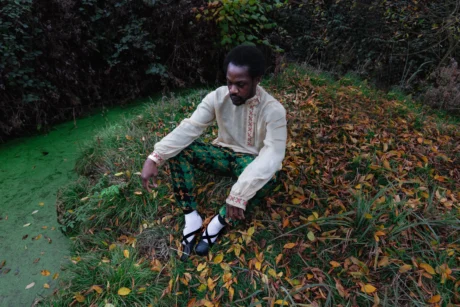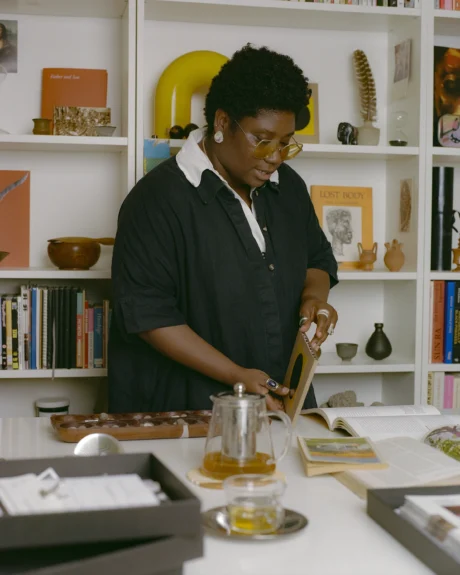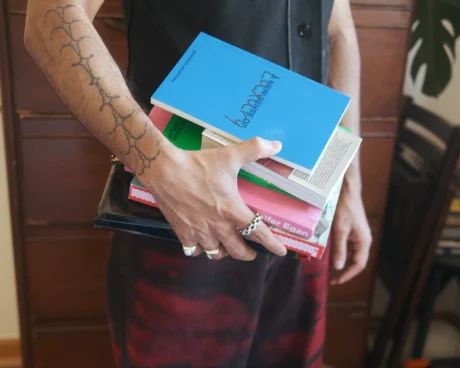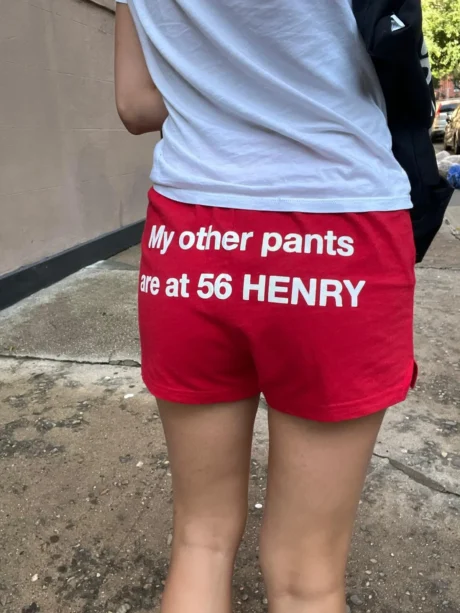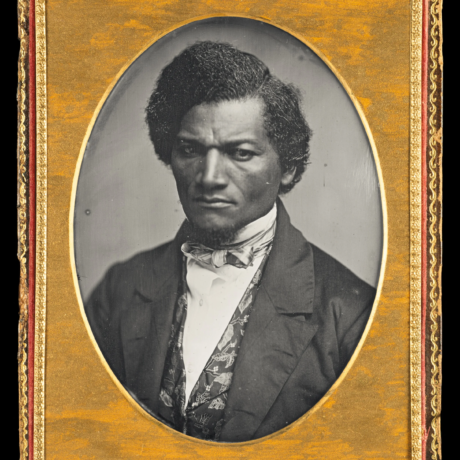Florence Peake and Eve Stainton were lovers first, and collaborators second. But now their practice and their relationship is somewhat inextricable. In this article for “The Lovers” Katie Tobin speaks with Florence and Eve ahead of their performance at AGM.
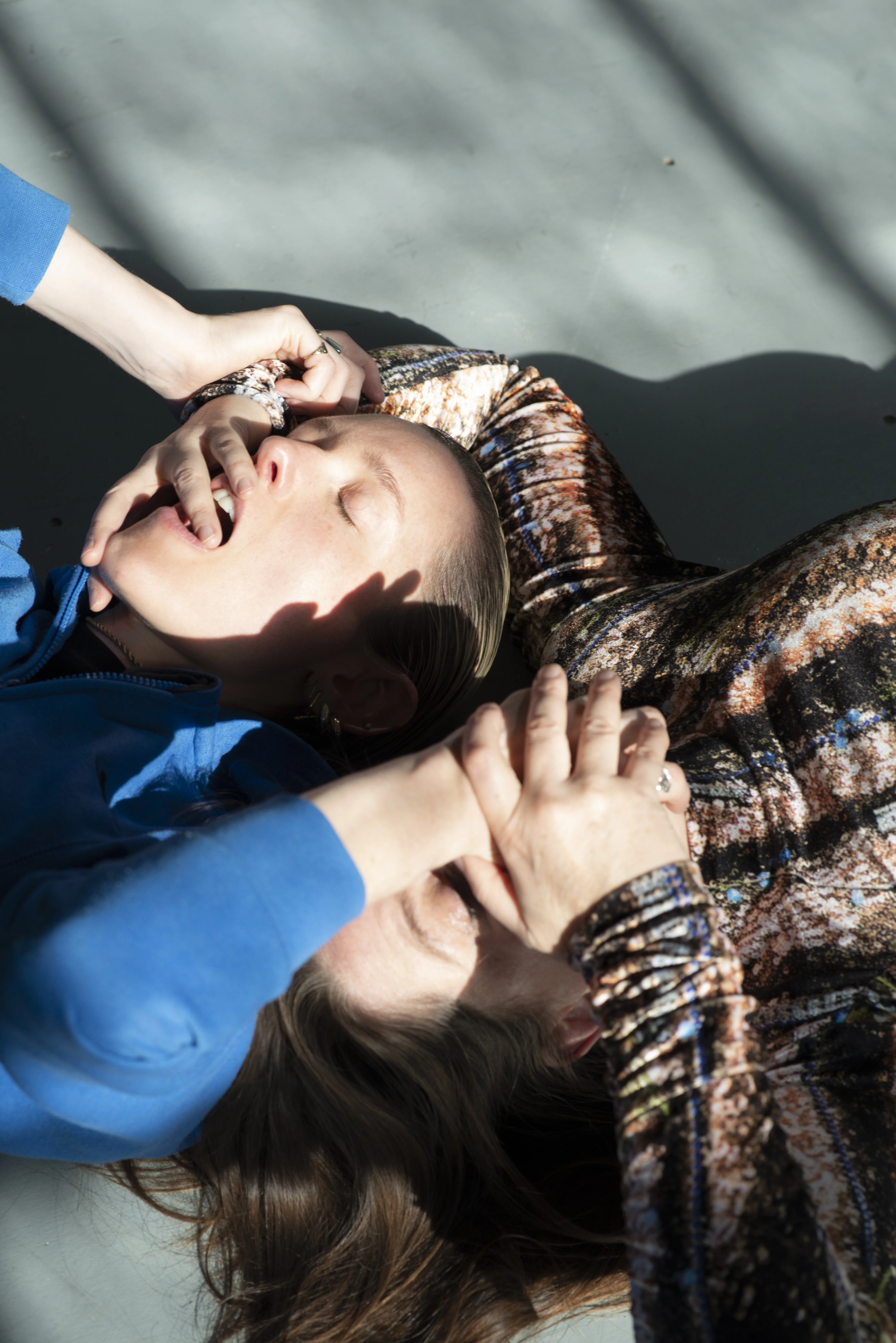
In a partnership that has crossed between performance, choreography, visual art and love, Florence Peake and Eve Stainton have developed a dynamic that resists easy categorisation. Their romantic and creative relationship forms the backbone of their practice, where their somatic and choreographic inquiries create immersive, physical performances that blur the boundaries between audience and performer. Their earlier collaborations like Slug Horizon blistered with sexual tension, and their new piece, an extract from Slug Horizons premiering at Somerset House Studio’s AGM on Friday, titled Practice 1, is equally physical. They’ll be navigating the space interlocked at the crotch.
As solo artists, their impressive output includes Peake’s Factual Actual series (2020–present) which combines figurative painting and performance, and Stainton’s Impact Driver (2023) which fuses dance, live art, and musical performance with wielding. These are vastly different mediums but as Peake tells me, it’s this ‘splatting of forms’ that has come to define their collaboration, using the body as a site of resistance and transformation.
Ahead of their performance at AGM we meet in the New Wing to discuss meeting at Duckie’s Gay Shame, the shifting dynamics of their personal and artistic relationship, and how their work navigates the interplay between queer intimacy, tactile materials, and audience consent.
KT: First of all, how did the two of you meet, and when did your artistic collaboration begin?
FP: We met through the field we’re both in, which is dance. We’re both choreographers. I come from less of a dance background, though it remains central to what I do, while you’re still deeply involved in performance and dance. Our work crosses over between what’s called live art, performance art, and dance. But originally, we both came from more theatrical, choreographed forms of performance.
ES: It sort of feels like we’ve progressively crossed over into visual art.
FP: I’m from a visual art background as well, and you’ve kind of been moving into that field. It’s a kind of splatting of forms.
ES: We met when a friend told me I should audition for a performance that Florence was holding. And I was like, ‘Oh, I’ve seen Florence’s work around. I’d really like to meet her.’ It’s so strange the kind of industry and how auditions are held sometimes, but I could sense this would be important.
FP: It was for Duckie, which is a big queer event, for an event called Gay Shame which runs along Pride.
ES: Sort of like an anti-capitalist resistance towards Pride. So, I came to that audition and got the job for that. That’s how we properly met, and it probably took us about a year to get together. But we started to make work quite quickly as soon as we started being in a relationship because I think that was a lot of our meeting points. How we met as friends, how we met as people was through work and performing choreography, thinking about all these things, and trying out ideas on each other.

KT: Does your relationship as romantic and artistic partners influence one another?
ES: In so many ways.
FP: It depends on what kind of artist you are, but relationships and conversation are often something that I find very stimulating. I think that there was a lot of chemistry and historically those kinds of relationships foster ideas and collaboration. It happens lots more than you probably think, but in our case, it’s quite explicit in our relationship. But I think there’s lots of dynamics where someone is more behind the scenes. There are also those late-night conversations where you’re kind of really tussling around with ideas.
ES: We’ve also experimented with different forms of collaboration as well. Then, when we took more time apart to focus on our independent practices more…
FP: We’ve had more dramaturgical support, and more choreographic feedback, outside these connections to each other’s practice.
ES: With the really intense, behind the scenes, collaborative work that happens when you live with an artist, it’s a bit difficult to switch off sometimes. I can feel and sense there’s something that’s not quite landing in what I’m exploring or about a direction that you might want to go in. I trust you so much around that now as we’ve got such a history together that it feels like you’re the person that I’d want to speak to about that.
FP: Yeah. When it really boils down to it, you want somebody that you really trust, that really knows you.
KT: I’m really interested in how many different mediums your practice spans. How do you decide which one best expresses an idea or concept?
ES: That’s a good question. It depends on whether you start with the idea and the concept or whether you start with the practice with the materials. It depends on which thing is leading. I mainly work with welding and steel and choreography and movement, and sometimes digital collage, but less so now. I see them as vocabularies a bit more now, that come in and out and might not always be present in every project. But I can draw on them when they make sense.
FP: I think it’s more natural to work like that. Even the idea that you listen to music while you might be painting a picture, that’s a kind of interdisciplinary practice. Celia Hampton has a guitar in her studio, and then she paints a bit. The music might not be part of the exhibition, but it’s part of the ecology of the work. And culturally, we’re leaning more towards fluidity in art. There are loads of interdisciplinary MAs, so it’s not an unusual thing. I teach in art schools, and the students will have multiple practices going on at the same time. We’re in a place where artistic feeling might distil itself into one thing, presenting itself as a painting or a movement, but it’s had a journey of being filtered through lots of different forms in a way that is quite interesting.
ES: I often think, what material or medium really makes sense to the message? I’ve had that sometimes with my own work. But also in mentoring, where you think, ‘This is a really clear, quite political, agenda that someone wants to speak to.’ And then you might witness part of their process and wonder if dance is the right form to use.
FP: Sometimes a particular form lends itself to an idea in a diabolical way. It could just be utterly cringe, but in another context, it might be what’s needed to articulate a certain sentiment or tenderness. It’s about what it’s trying to accomplish or to push, that desire you have to be understood through a certain medium.
KT: Could you talk a bit about your collaborative process?
ES: We started collaborating about seven years ago. Our intimate relationship and performance practice were so interwoven that a lot of the work was quite explicit, sexually charged, and fuelled by chemistry. It was really about how to take something private into the public realm – pushing the boundaries of what a performance could hold by involving the audience in intimate situations.
FP: In our first performance, Slug Horizons, nudity and audience participation were central. But over time, we began focusing more on our individual presence. What we’re performing at Somerset House is extracted from that first work.
ES: We’ve zoomed in on it and stripped down to its formal concerns. We’ve gone into it like a study, fully clothed where we weren’t previously.
FP: We were pairing down to the formal concerns of what that practice is, rather than necessarily an agenda of wanting to make the lesbian body explicit which, at that time, was very marginalised in relation to dance.
ES: What remains is the exploration of the physical connection between our bodies. It’s about negotiating weight and balance while maintaining connection – a metaphor for how to relate through differences.
FP: It’s about power dynamics, communication, and hoping those elements reflect broader concerns in the world.
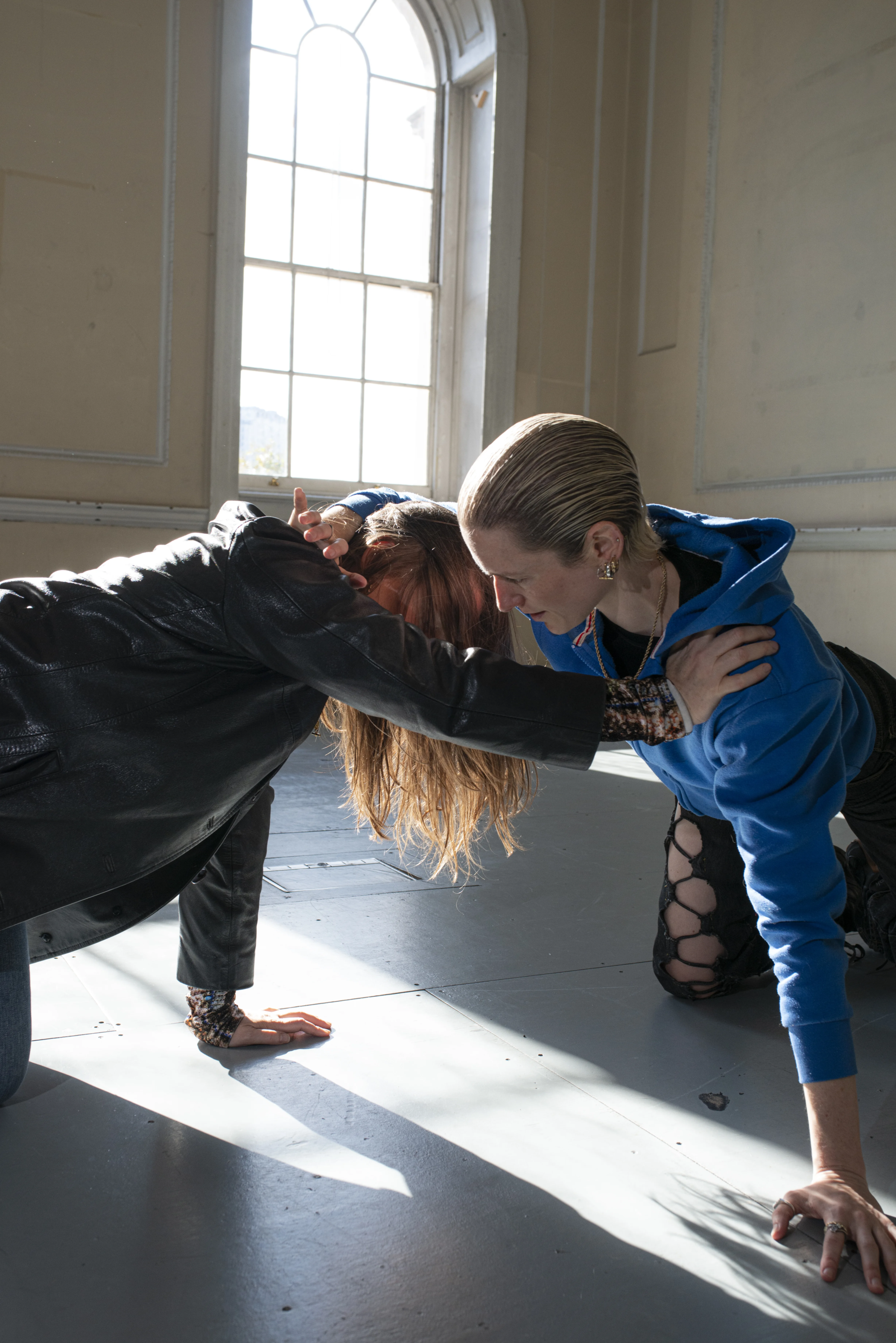
KT: Your performances often create intimate spaces between performers and the audience. What do you think about the role of the audience in your work?
ES: The audience is such a crucial part of our performances; they really become another medium that shapes the entire experience. The unique layout of our space invites close proximity, blurring the lines between performer and spectator.
FP: In this way, the practice really responds to architecture. We both have a relationship with blurring the boundaries between spectator, performer, audience, and live work. It’s about crafting the art of consent practices with the audience; it’s a whole material to work with, how you include them in all of that.
ES: How you might offer something where an audience member feels like they can decline, almost sacrificing all the elements of your own expectation of how the show is going to go. In my performance Dykegeist, I invited audience members to participate in simple tasks, and when some declined, I thought, ‘Oh, well, this is the show.’
FP: It really drove home the importance of embracing those awkward moments. We’re all about creating atmospheres where audiences feel comfortable yet aware of the ‘weirdness’ that can come with participation. It makes the shared experience all the more meaningful.
KT: How do you approach the themes of sensuality and queerness in your art?
FP: Eve tackles it head on! I approach themes of sensuality, queerness, and intimacy head-on, focusing on the materiality of my practice. Sensuality is a strategy for how I relate to materials like clay, which has this alchemical quality – it transforms constantly, and I’m drawn to that fluidity, the way it keeps shifting states. I love working with those tensions, the precarity, the non-fixity.
ES: In my work, I think a lot about the people I’m working with. At the moment, for Impact Driver, I collaborate with a group of trans men, butch lesbians, and non-binary individuals who aren’t trained in contemporary dance. I’m really interested in engaging communities that experience movement without the baggage of traditional dance training, allowing their physicality to reflect who they are.
FP: Our romantic relationship adds another layer to our work, where the richness of the tensions in a queer relationship informs my practice, creating a frame that colours the work in a beautiful way.
KT: What excites you about the future of performance art?
ES: There’s definitely more of a visibility of transdisciplinary artists. There’s a real inclination right now for these artists to be showcased, which I find thrilling.
FP: But I also see the challenges, like the flooding of performance art where people think that anyone can do it. Sometimes that leads to a lack of ambition in new works. I’d love to see more artists getting better funding to create ambitious projects that reflect their talent. Performance art remains a language of resistance and a political act; it’s rooted in the live encounter between performers and audiences. It’s a space where we can explore intimacy and engagement, something increasingly rare in everyday life.
ES: While digital art is amazing, performance offers a unique experience that can’t be replicated online. I think there’s a lot of potential for powerful, experimental works if we can just navigate the current funding landscape.
Words by Katie Tobin
All photography by Saffron Liberty
Tickets available
Please find tickets for AGM 2024 here.
